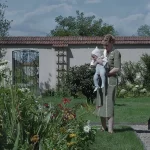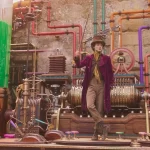Castles in the Sky: My Neighbor Totoro, by Aaron Pinkston
My Neighbor Totoro kicks off with one of the most ridiculously delightful opening sequences, animated or otherwise. With cobwebs, grasshoppers, spiders, general creepy-crawlies, bats, worms, and a morphing puffy white creature, all dancing to a sugary-sweet Japanese pop song, it is impossible not to love. That’s sort of a microcosm for the entire film — impossible not to love.
One of the absolute pillars of Studio Ghibli, I was glad to finally getting the chance to see My Neighbor Totoro. From South Park to the background of Toy Story 3, the film’s influence has spanned throughout nearly every form of popular animation. For those who don’t know, the film centers on two young sisters and their father, who have recently moved into an old house that offers a bit of magic during some trying times. While exploring their new digs, Satsuki (age 10) and Mei (age 4) are enchanted by strange dust fairies which scatter upon light. This isn’t the extent to the magic in their neighborhood, as Mei comes across Totoro, a giant cat-dog-owl-pikachu hybrid with an affinity for acorns. As a person who doesn’t care for people between the ages of 4 and 10, the girls were pretty quick to get on my nerves with all their screaming and running and mischievousness. OK, so they were a little endearing.
As for Totoro, it is easy to love him (her?) unconditionally. Truly one of the weirdest animated characters of all time, it infringes on the absurd. From the top of my head the creature has the ability to grow trees quickly, be invisible to adults, fly (or at least jump really high), play a flute-like instrument that seems to mellow everyone out, etc. The strangeness doesn’t stop with Totoro, as he has two side-kicks who are basically the same thing in two smaller sizes. Oh, and a cat that is also a bus. The “catbus” (as it is properly listed) is a Cheshire cat-like figure with the added advantage of being an invisible mode of transport. Best of all, though, is that the film doesn’t take any time to justify or explain these oddities — it understands that its target audience (kids) will just accept it, just as the two young protagonists do.
This is Studio Ghibli’s take on a haunted house film, at least one where the hauntings are cute, cuddly creatures. Kids in haunted houses has always been a staple for the subgenre, whether in animated children’s films or actual horror. The idea of seeing monsters through a child’s eyes speaks for itself — children often have the imaginations that facilitate ghosts and goblins, and the perspective to make normal-ish things scary. What My Neighbor Totoro does isn’t dissimilar to something like Don’t Be Afraid of the Dark, except when the young girls see the monsters and creepies, they fully embrace them. During the opening of the film, before the discovery of Totoro, there is a lot of horror imagery, molded into this child-friendly world. A scene where the girls must go up a dark staircase into the upstairs attic is something completely frightening in another film. In fact, when an acorn slowly dribbles down these stairs, it nearly comes to a genuine chiller.
Though highly praised, I didn’t find the film to be perfect. A problem I had with the film was how it handled its dramatic elements, especially in the final act. I’ve found that the greatest fantasy films are able to seamlessly blend the fantasy elements in with the hard drama of real life — think Pan’s Labyrinth and other Ghibli films Spirited Away and The Secret Life of Arrietty. In these films, the fantasy becomes a way for the young protagonists to escape their otherwise troubled, painful lives. A major plotpoint of My Neighbor Totoro involves the young girls’ mother being hospitalized — though I don’t think we know the reason for her internment, she is away from her family for the entire film. For the most part, no one seems negatively affected at all, which is fine, it’s probably nothing too serious. In the last 20 minutes of the film, however, the film plunges straight for the worse, with a telegram from the hospital, which leads the younger daughter off to the hospital only to get lost. When everything is settled it turns out there was nothing really wrong with the mother, just a cold, and she speculates why the hospital would even send a notice. Other Ghibli films don’t pull dramatic punches, teaching their young viewers about death and its place in the world, and while I don’t mean to be blood-thirsty, it seemed like a bit of a cop out. I realize there needed to be some sort of drama to pick the plot up and give the film some sort of resolution, but I just wasn’t satisfied by how the film shovelled this in right at the end.





























